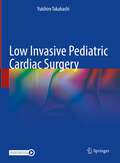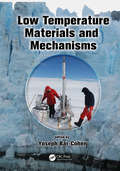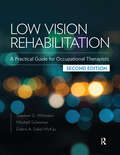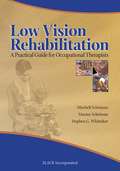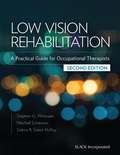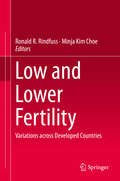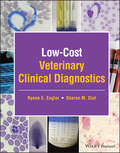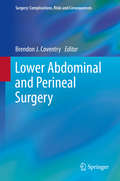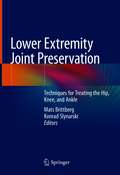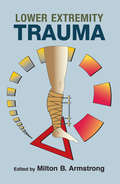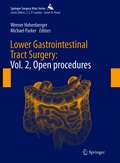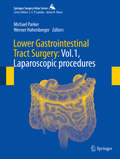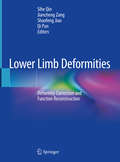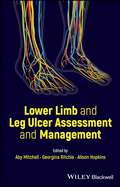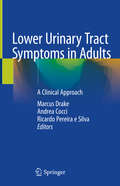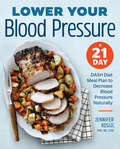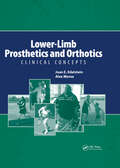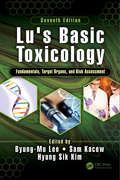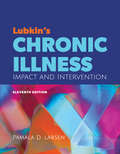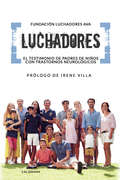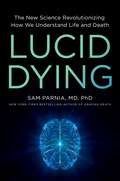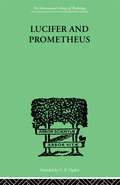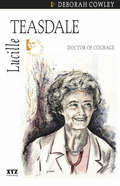- Table View
- List View
Low Invasive Pediatric Cardiac Surgery
by Yukihiro TakahashiThis book demonstrates the significance of minimally invasive extracorporeal circulation and reduced time as two of the most important factors for pediatric cardiac surgery and early postoperative recovery. The content is divided into three major thematic sections: low invasiveness; pitfalls and countermeasures before, during and after operations; and suggestions on time-saving and team building. Abundant figures aid in comprehension, while videos of the surgery offer practical insights for readers at all levels. Advances in extracorporeal circulation devices and management have led to new clinical problems such as decreased perfusion pressure, high pressures in oxygenators, and changes in acid-base equilibrium. The book explains these problems both clinically and experimentally, and describes countermeasures. Low Invasive Pediatric Cardiac Surgery provides valuable evidence and practical suggestions for all surgeons, perfusionists, scrub-nurses, and anesthesiologists who are engaged in pediatric cardiac surgery. It will also appeal to pediatric cardiologists and medical device manufacturers. The book is intended to share the author’s experience and actual data with readers who have clinical experience, and to help prepare beginners.
Low Temperature Materials and Mechanisms
by Yoseph Bar CohenThis book addresses the growing interest in low temperature technologies. Since the subject of low temperature materials and mechanisms is multidisciplinary, the chapters reflect the broadest possible perspective of the field. Leading experts in the specific subject area address the various related science and engineering chemistry, material science, electrical engineering, mechanical engineering, metallurgy, and physics.
Low Vision Rehabilitation: A Practical Guide for Occupational Therapists
by Mitchell Scheiman Stephen Whittaker Debra Sokol-McKayThis Second Edition of Low Vision Rehabilitation: A Practical Guide for Occupational Therapists provides current, evidence-based information on low vision rehabilitation that contains several new and expanded chapters on ADLs, IADLs, and recreation, as well as new online resources and the latest in accessibility devices.Low vision rehabilitation is rapidly growing as a specialty practice for occupational therapists. This growth requires practical, evidence-based information on the evaluation and treatment of the effects of low vision on occupational performance. Responding to this need, Low Vision Rehabilitation: A Practical Guide for Occupational Therapists, Second Edition blends standards of practice that have been developed for over 50 years by low vision therapists and optometrists, with the latest scientific research and the unique perspective of occupational therapists.This text is written to introduce the student and general practitioner to low vision rehabilitation as commonly encountered in medical rehabilitation as well as provides a conceptual approach to evaluation and treatment that will enrich an advanced practice. Authors Stephen Whittaker, a low vision researcher, certified low vision therapist and occupational therapist, Mitchell Scheiman, an optometrist and researcher, and Debra Sokol-McKay, an occupational therapist with specialty certification in low vision as well as certification as a low vision therapist, vision rehabilitation therapist and diabetes educator, have carefully selected evidence-based evaluations and treatments that focus on clinical practicality and meaningful occupational goals in adults.New to the Second Edition: A focus on occupational performance using “whatever works,” whether visual, non-visual, or a combination of these different devices and adaptive techniques The “EPIC” Framework, a general strategy to organize a treatment plan for daily activities using visual and non-visual techniques Access to a companion website designed as a handy clinical reference, with solutions to clinical problems easily searchable and cross-linked to related content The “Success-Oriented Approach” to interventions based on the most recent research on cognitive disability and depression associated with low vision Applications of the latest electronic accessibility devices including smartphones, tablets, and magnifiers that read aloud Incorporates the AADE™ 7 Self-Care Behavior framework of the American Association of Diabetes Educators Incorporates concepts from the latest edition of the AOTA Occupational Therapy Practice Framework: Domain and Process A chapter devoted to field loss, spatial neglect and perceptual impairments resulting from acquired-brain-injury. The latest in Medicare documentation standards including outcome to G-code conversions and ICD-10 diagnostic coding for low vision. Included with the text are online supplemental materials for faculty use in the classroom.Features Included: Recommended practical evaluation and treatment methods such as a 1 hour evaluation protocol, how to write observable and measurable goals and document outcomes, and specific instructions on how to implement treatments Prepares therapists for the ACVREP certification as a low vision therapist or vision rehabilitation or AOTA specialty certification in low vision Emphasizes intervention and low vision rehabilitation treatment including: modification of the environment adaptive visual and non-visual techniques selection and use of non-optical assistive devices selection and use of electronic and optical devices and use of computer technology including smartphones and tablets Comprehensive case studies on vision impairment resulting from eye disease to head injury and more Provides valuable in
Low Vision Rehabilitation: A Practical Guide for Occupational Therapists
by Mitchell Scheiman Maxine Scheiman Stephen G. WhittakerLow vision rehabilitation is rapidly growing as a specialty practice for occupational therapists. This growth requires practical, evidence-based information on the evaluation and treatment of the effects of low vision on occupational performance. Responding to this need, Low Vision Rehabilitation: A Practical Guide for Occupational Therapists blends standards of practice that have been developed over 50 years by low vision therapists and optometrists, with the latest scientific research and the unique perspective of occupational therapists. Low Vision Rehabilitation presents an emerging model in which occupational therapists practice as part of a team of vision rehabilitation professionals serving adults with low vision. Occupational therapists offer a unique contribution to the vision rehabilitation team, with a focus on meaningful occupational goals, the incorporation of occupation into therapy, and the orchestration of environmental, social, and non-visual personal factors into a treatment plan. Mitchell Scheiman, Maxine Scheiman, and Stephen Whittaker have developed a practical and straightforward text outlining an evaluation approach to interventions that focus on recovering occupational performance in adults. Special features * Incorporates concepts from the AOTA Occupational Therapy Practice Framework: Domain and Process * Provides most of the core knowledge required for the ACVREP low vision certification examination and AOTA specialty certification in low vision * Includes an occupational therapy vision rehabilitation evaluation consisting of four components: occupational profile/case history, evaluation of visual factors, environmental evaluation, evaluation of occupational performance * Emphasizes intervention and low vision rehabilitation treatment including modification of the environment, use of non-optical assistive devices, use of optical devices, and use of computer technology * Provides valuable information on how to start an independent practice in low vision rehabilitation * Includes chapters on diabetic management and electronic assistive technology * Includes access to a companion website with printable forms and additional resources with text purchase Written by authors who are optometrists, occupational therapists, researchers, and certified low vision therapists (CLVT), Low Vision Rehabilitation employs an interdisciplinary perspective that is unique, practical, and credible.
Low Vision Rehabilitation: A Practical Guide for Occupational Therapists (Second Edition)
by Mitchell Scheiman Stephen G. Whittaker Debra A. Sokol-MckayThis Second Edition of Low Vision Rehabilitation: A Practical Guide for Occupational Therapists provides current, evidence-based information on low vision rehabilitation that contains several new and expanded chapters on ADLs, IADLs, and recreation, as well as new online resources and the latest in accessibility devices. Low vision rehabilitation is rapidly growing as a specialty practice for occupational therapists. This growth requires practical, evidence-based information on the evaluation and treatment of the effects of low vision on occupational performance. Responding to this need, Low Vision Rehabilitation: A Practical Guide for Occupational Therapists, Second Edition blends standards of practice that have been developed for over 50 years by low vision therapists and optometrists, with the latest scientific research and the unique perspective of occupational therapists. This text is written to introduce the student and general practitioner to low vision rehabilitation as commonly encountered in medical rehabilitation as well as provides a conceptual approach to evaluation and treatment that will enrich an advanced practice. Authors Stephen Whittaker, a low vision researcher, certified low vision therapist and occupational therapist, Mitchell Scheiman, an optometrist and researcher, and Debra Sokol-McKay, an occupational therapist with specialty certification in low vision as well as certification as a low vision therapist, vision rehabilitation therapist and diabetes educator, have carefully selected evidence-based evaluations and treatments that focus on clinical practicality and meaningful occupational goals in adults.
Low Vision: A Resource Guide with Adaptations for Students with Visual Impairments
by Nancy Levack Gretchen Stone Virginia BishopA user friendly guide to current philosophies on up-to-date medical, optical, and technical information, and practical methodologies and adaptations for Students with Visual impairments.
Low and Lower Fertility
by Ronald R. Rindfuss Minja Kim ChoeThis volume examines two distinct low fertility scenarios that have emerged in economically advanced countries since the turn of the 20th century: one in which fertility is at or near replacement-level and the other where fertility is well below replacement. It explores the way various institutions, histories and cultures influence fertility in a diverse range of countries in Asia, Europe, North America and Australia. The book features invited papers from the Conference on Low Fertility, Population Aging and Population Policy, held December 2013 and co-sponsored by the East-West Center and the Korea Institute for Health and Social Affairs (KIHASA). It first presents an overview of the demographic and policy implications of the two low fertility scenarios. Next, the book explores five countries currently experiencing low fertility rates: China, Hong Kong, Japan, Singapore and South Korea. It then examines three countries that have close to replacement-level fertility: Australia, the Netherlands and the United States. Each country is featured in a separate chapter written by a demographer with expert knowledge in the area. Very low fertility is linked to a number of conditions countries face, including a declining population size. At the same time, low fertility and its effect on the age structure, threatens social welfare policies. This book goes beyond the technical to examine the core institutional, policy and cultural factors behind this increasingly important issue. It helps readers to make cross-country comparisons and gain insight into how diverse institutions, policies and culture shape fertility levels and patterns.
Low-Cost Veterinary Clinical Diagnostics
by Sharon M. Dial Ryane E. EnglarLow-Cost Veterinary Clinical Diagnostics A practical guide to maximizing the diagnostic value of in-house quick assessment tests (QATs) In Low-Cost Veterinary Clinical Diagnostics, the authors provide a hands-on resource designed to facilitate healthcare delivery across the spectrum of care. Historically, clinicians have been taught to apply the gold standard approach to the practice of medicine. However, recent advances in veterinary medical care and associated technologies have made practitioners question whether a one-size-fits-all approach is truly best. After all, when we perform diagnostic tests, are we testing out of the desire for completeness, to cover all bases for the good of the patient? Or are we testing because we are expected to? The reality is that gold standard care is not always advisable and not always possible. In clinical practice, veterinarians frequently encounter obstacles that limit their approaches to case management. Cost of care is a significant constraint that requires practitioners to rethink which diagnostic tests are essential. Not every patient requires a complete blood count (CBC), chemistry profile, urinalysis, and fecal analysis to obtain diagnostic value. This text suggests that the “best” approach to case management be determined by the situation, the context, the patient, and the client. While sophisticated panels of tests may remain the recommended approach to case management, Low-Cost Veterinary Clinical Diagnostics outlines entry-level, in-house diagnostic blood, urine, fecal, and body cavity fluid tests: how to perform them as well as the breadth and depth of patient-specific data that can be gleaned from quick assessment tests (QATs). Readers will also find: A thorough introduction to patient care considerations, communication strategies that facilitate cost-conscious shared decision-making Comprehensive explorations of quick assessment tests (QATs) in hematology, including packed cell volume (PCV), total solids (TS), buffy coat analysis, blood smears, blood glucose, blood urea nitrogen (BUN), saline agglutination tests, and activated clotting time. Practical discussions of quick assessment tests (QATs) involving urine, including urine color, dipstick analysis, specific gravity (USG), and urine sediment analysis Pragmatic evaluation of fecal analysis, including considerations surrounding fecal color, volume, consistency, and odor; saline smears or wet mounts, and fecal flotation. Discussion on body cavity fluid analysis Sample case vignettes, complete with question and answer (Q&A) Perfect for veterinary practitioners, veterinary technicians, veterinary and veterinary technician students, Low-Cost Veterinary Clinical Diagnostics offers a quick and easy reference guide to maximizing diagnostic value in those cases where care is cost-prohibitive.
Low-Dose Radiation Effects on Animals and Ecosystems: Long-Term Study on the Fukushima Nuclear Accident
by Manabu FukumotoThis open access book summarizes the latest scientific findings regarding the biological effects of the Fukushima Daiichi Nuclear Power Plant (FNPP) accident in 2011.Various cases of changes in animals and organisms have been reported since the FNPP accident. However, it is often unknown whether they are actually due to radiation, since the dose or dose-rate are not necessarily associated with the changes observed. This book brings together the works of radiation biologists and ecologists to provide reliable radioecology data and gives insight into future radioprotection.The book examines the environmental pollution and radiation exposure, and contains valuable data from abandoned livestock in the ex-evacuation zone and from wild animals including invertebrates and vertebrates, aqueous and terrestrial animals, and plants that are subjected to long-term exposure in the area still affected by radiation. It also analyzes dose evaluation, and offers new perspectives gained from the accident, as well as an overview for future studies to promote radioprotection of humans and the ecosystem.Since the biological impact of radiation is influenced by various factors, it is difficult to scientifically define the effects of low-dose/low-dose-rate radiation. However, the detailed research data presented can be combined with the latest scientific and technological advances, such as artificial intelligence, to provide new insights in the future.This book is a unique and valuable resource for researchers, professionals and anyone interested in the impact of exposure to radiation or contamination with radioactive materials.
Lower Abdominal and Perineal Surgery
by Brendon J. CoventryWritten by internationally acclaimed specialists, Lower Abdominal and Perineal Surgery provides pertinent and concise procedure descriptions spanning benign and malignant problems and minimally invasive procedures. Complications are reviewed when appropriate for the organ system and problem, creating a book that is both comprehensive and accessible. Stages of operative approaches with relevant technical considerations are outlined in an easily understandable manner. Forming part of the series, Surgery: Complications, Risks and Consequences, this volume Lower Abdominal and Perineal Surgery provides a valuable resource for all general surgeons and residents in training. Other healthcare providers will also find this a useful resource.
Lower Extremity Joint Preservation: Techniques for Treating the Hip, Knee, and Ankle
by Mats Brittberg Konrad SlynarskiThis book describes and discusses the available joint preservation techniques for maintaining the stability homeostasis of the lower extremity joints – specifically the hip, knee, and ankle – following injury. Readers will find detailed coverage of anatomy, pathology, techniques for repair, restoration, and regeneration, and rehabilitation strategies. Joint preservation is an emerging field in Orthopaedics that represents a response to the limitations of joint replacement technology. Using the techniques now available, surgeons can try to prevent or delay the onset of osteoarthritis or other degenerative conditions affecting the joints, particularly in young patients. Furthermore, modern tissue engineering offers the potential for whole-joint resurfacing, thereby achieving complete restoration. Optimal implementation of these techniques depends upon further refinement of methods and continuing improvements in knowledge of biomechanics, biology, and anatomy. Against this background, the present book is an ideal guide to the latest treatment modalities that will appeal to all who wish to learn more about indications, goals, procedures, and expected outcomes.
Lower Extremity Trauma
by Milton B. ArmstrongWith an abundance of case studies from Jackson Memorial Hospital, this reference provides expert guidance on the evaluation and treatment of lower extremity orthopedic injuries. Analyzing the function and interrelationships of the muscular and skeletal systems of the lower extremities, this source discloses key principles in trauma management, deci
Lower Gastrointestinal Tract Surgery: Vol. 2, Open procedures (Springer Surgery Atlas Series)
by Michael Parker Werner HohenbergerThis atlas, containing a wealth of clear operative images, is designed to enable trainee surgeons to visualise the surgical field for procedures specific to open colorectal surgery, thereby facilitating understanding and learning of surgical techniques and avoidance of intra- and postoperative complications. Step-by-step guidance is provided for a wide range of procedures to the colon, rectum, pelvic floor, anus and anal canal, in each case paying meticulous attention to surgical anatomy. The full range of potential indications for open surgery is considered, including benign and malignant tumours, inflammatory bowel disease, appendicitis, diverticulitis, hemorrhoids, anal fistulas and rectal prolapse among others. Whenever considered necessary, additional line drawings are included to aid comprehension of particular steps in the surgery. Readers seeking to improve their understanding of surgical anatomy and how to perform these operative procedures will find the atlas to be an unparalleled source of information and assistance. A complementary book from the same authors focuses on laparoscopic colorectal surgery.
Lower Gastrointestinal Tract Surgery: Vol.1, Laparoscopic procedures (Springer Surgery Atlas Series)
by Michael Parker Werner HohenbergerThis atlas, containing a wealth of clear operative images, is designed to enable trainee surgeons to visualise the surgical field for procedures specific to laparoscopic colorectal surgery, thereby facilitating understanding and learning of surgical techniques and avoidance of intra- and postoperative complications. Step-by-step guidance is provided for a wide range of procedures employed in patients with benign and malignant tumours, inflammatory bowel disease, diverticular disease, rectal prolapse and other conditions. Examples include right colectomy techniques, sigmoid colectomy, left hemicolectomy, total colectomy, panproctocolectomy, total mesorectal excision, Hartmann’s procedure and its reversal and rectopexy. Throughout, meticulous attention is paid to surgical anatomy. Whenever considered necessary, additional line drawings are included to aid comprehension of particular steps in the surgery. Readers seeking to improve their comprehension of surgical anatomy and how to perform these operative procedures will find the atlas to be an unparalleled source of information and assistance. A complementary book from the same authors focuses on open colorectal surgery.
Lower Limb Deformities: Deformity Correction and Function Reconstruction
by Sihe Qin Jiancheng Zang Shaofeng Jiao Qi PanThe diagnosis and treatment described in this book is based on the combination of Ilizarov technique, Paley’s principle and Qinsihe Natural Reconstruction theory. It covers all kinds of lower limb deformities, ranging from congenital deformities to acquired deformities, the sequelae of Poliomyelitis, Cerebral Palsy, Spina Bifida Sequelae, Traumatic Sequelae, Charcot-Marie-Tooth disease, Osteogenesis Imperfecta and Congenital Pseudarthrosis Tibia, etc. There are also lots of clinical tips and tricks such as how to reduce radiation exposure during orthopaedic surgeries, how to correct multiple limb deformities in one stage, how to balance the dynamic muscle in complex foot and ankle deformities, and how to successfully accomplish the surgery of difficult lower limb reconstruction without allogeneic blood transfusion, etc.It is a valuable reference for orthopaedic surgeons and advanced trainees worldwide who interested in deformity correction and limb reconstruction.
Lower Limb and Leg Ulcer Assessment and Management
by Aby Mitchell Georgina Ritchie Alison HopkinsLower Limb and Leg Ulcer Assessment and Management Lower Limb and Leg Ulcer Assessment and Management is an indispensable resource for practitioners in primary and secondary care, offering a practical and accessible guide to treating and managing leg ulcers. This comprehensive text challenges the misconception that leg ulcers are invariably ‘chronic’. In practice, proactive management will prevent the harm associated with sub-optimal management. Insights are provided into lower limb assessment, early intervention for ulcer prevention, ulcer types and their causes, along with the influence that swelling and biomechanical changes have on the lower limb. The authors draw on international best practice guidance on lymphoedema, wound pain, wound bed preparation, compression therapy, psychological impact, and evidence-based care to enhance leg ulcer management. Each chapter aims to facilitate reader comprehension and promote productive patient discussions, empowering healthcare professionals to collaborate with patients and improve leg ulcer management rapidly and effectively. This multi-disciplinary resource covers: Normal venous, arterial, and lymphatic function in the lower leg Leg ulceration due to venous hypertension, peripheral arterial disease, and lymphoedema Leg ulcers of unusual aetiology, addressing autoimmune and inflammatory disorders such as pyoderma gangrenosum, rheumatoid arthritis, scleroderma, sickle cell, and more Musculoskeletal changes in the lower limb, assessment, and management to enhance mobility and calf-muscle function Clinical management, with topics like wound management, stages of wound healing, exudate management, holistic assessment including vascular assessment, compression therapy, and Laplace’s law Pain management with an emphasis on understanding the complexities and features that exacerbate or diminish the pain response The personalisation of care, understanding of social determinants of health, and the role of supportive self-management in lifelong management For professionals seeking evidence-informed approaches to delivering exceptional care, Lower Limb and Leg Ulcer Assessment and Management is an essential companion on the journey to understanding and managing leg ulcers effectively.
Lower Urinary Tract Symptoms in Adults: A Clinical Approach
by Marcus Drake Andrea Cocci Ricardo Pereira e SilvaThis book provides an in-depth insight into the symptoms and symptom complexes affecting the lower urinary tract and the underlying causative conditions. The emphasis throughout is practical and clinical, with coverage of all levels of the patient pathway. In addition to the extensive guidance on diagnostic assessment and interpretation, the management of voiding and storage lower urinary tract symptoms, including incontinence, is fully described and potential complications and neurological conditions are discussed. Information is also included on relevant basic science and epidemiology. Lower Urinary Tract Symptoms in Adults: A Clinical Approach will be an ideal source of expert knowledge for practitioners in functional urology, urogynecology, and neuro-urology gerontology. .
Lower Your Blood Pressure: A 21-Day DASH Diet Meal Plan to Decrease Blood Pressure Naturally
by Jennifer Koslo RNDEat your way to lower blood pressure. There are ways to help treat high blood pressure that don't require medications with unpleasant side effects. Lower Your Blood Pressure provides you with the guidance you need to manage your hypertension with the foods you eat. It's also filled with heart-healthy advice and delicious DASH (Dietary Approaches to Stop Hypertension) diet recipes. The DASH diet focuses on improving your blood pressure using foods that are low in sodium and high in magnesium and potassium. New to DASH? Lower Your Blood Pressure makes things easy with a three-week meal plan—complete with shopping lists—designed to get you started on the right (and yummy) path. Lower Your Blood Pressure includes: 21-day meal plan—Jump right into healthy eating with a simple and straightforward meal plan that helps you adjust to the DASH diet in just three weeks. 75+ quick and easy recipes—From Stuffed Breakfast Peppers to Pecan-Crusted Catfish, start deciding your own meals using these healthy and mouthwatering options. Hypertension explained—Learn all about how to manage your blood pressure naturally, including dietary goals, de-stressing tips, exercise advice, and more. Take the pressure off with this complete dietary guide to lowering your blood pressure.
Lower-Limb Prosthetics and Orthotics: Clinical Concepts
by Joan Edelstein Akex MorozLower-Limb Prosthetics and Orthotics: Clinical Conceptsis a comprehensive overview of lower-limb prosthetics and orthotics, covering normal and pathological gait, lower-limb biomechanics, clinical applications, as well as prosthetic and orthotic designs and components. Joan Edelstein and Alex Moroz have writtenLower-Limb Prosthetics and Orthotics with the clinician’s perspective in mind. Clinical management is incorporated throughout the text, including basic surgical concepts, postoperative management, preprosthetic care, and training in the use of devices. Additionally, this text incorporates unique features relevant to physicians such as prescription writing and prosthetic and orthotic construction and modification, as well as, the latest research regarding energy consumption and long-term utilization of prostheses.Chapters Include: Orthotics in neuromuscular diseases Orthotics in pediatrics Functional expectations Gait and activities training Transtibial and transfemoral prostheses and components Transtibial and transfemoral biomechanics, evaluation, and gait analysis Disarticulations and Bilateral Amputations With over 150 line drawings and photographs to supplement the text, Lower-Limb Prosthetics and Orthotics: Clinical Concepts is ideal for clinicians in the fields of physical medicine and rehabilitation, orthopedics, vascular surgery, physical therapy and occupational therapy.
Lu's Basic Toxicology: Fundamentals, Target Organs, and Risk Assessment (7th Edition)
by Byung-Mu Lee Sam Kacew Hyung Sik Kim<p>Continuing a long tradition, Lu’s Basic Toxicology, Seventh Edition, combines relatively comprehensive coverage of toxic substances in food, air, and water with brevity, thereby continuing to serve as an updated introductory text for toxicology students and for those involved in allied sciences that require a background in toxicology. The new edition, which now becomes an edited work with contributions from experts around the globe, features four new chapters and a number of existing chapters that have been updated and expanded, notably those on mechanisms of toxic effects, conventional toxicity studies, the cardiovascular system, and risk assessment and regulatory toxicology. <p>The book consists of four parts (Part I–Part IV) that provide guidance on principles of toxicology and testing procedures for toxicities as well as a concise, yet detailed, mechanism of both target organ and nontarget organ toxicities. The book is rounded off with a final section (Part IV) on the toxic effects of chemicals and risk assessment, giving toxicologists, both students and practicing professionals, the necessary tools to enhance their practice. This edition includes new chapters on Clinical Toxicology, Systems Toxicology, Chemicals and Children, and Toxicology of Reproductive Systems, providing the essentials of these topics in the same style as the other chapters in the book. With separate subject and chemical indexes, this is a useful, quick shelf reference for everyone working in toxicology today.</p>
Lubkin's Chronic Illness: Impact and Intervention
by Pamala D. Larsen. Lubkin’s Chronic Illness: Impact an Intervention, Eleventh Edition provides a solid foundation for nursing students by teaching them the skills and knowledge they need to care for patients experiencing illness.
Luchadores: El testimonio de padres de niños con trastornos neurológicos
by Fundación Luchadores AvaPrólogo de Irene Villa. «Tienen en sus manos un libro sobrecogedor que inquieta pero nos llena de amor y esperanza, es un auténtico alegato de vida, de encontrar la forma y la actitud necesarias para luchar sin descanso y de no rendirse jamás». Irene Villa. Esta es una obra, ante todo, alegre, optimista, motivadora, inspiradora un canto a la vida. Un libro que te hará llorar y reír, y que sacará lo mejor de ti. Te hará ver la vida de otra manera y afrontarla con mayor fuerza y alegría. A través de él vivirás más de once vidas, las vidas de once padres y un abuelo que te contarán cómo afrontan la enfermedad de su hijo. No los oirás quejarse o maldecir su suerte. Te hablarán del amor que sienten por sus hijos, de cómo han cambiado sus vidas, sus prioridades y su forma de pensar. Te enseñarán a afrontar los pequeños o grandes problemas diarios mediante sus propias vivencias y, sobre todo, te irás con una gran lección: que el amor que siente un padre por su hijo todo lo puede. Conocerás la lucha diaria de estos niños que no tienen voz, queson los grandes olvidados de una sociedad atareada que ha perdido sus valores. Niños que con sus grandes sonrisas y sus ganas de vivir son capaces de cambiar a cualquiera que se cruce en su camino y se detenga a conocerlos. ¡Déjate cambiar por ellos!
Lucid Dying: The New Science Revolutionizing How We Understand Life and Death
by Sam ParniaFrom internationally renowned expert in resuscitation and New York Times bestselling author Sam Parnia, MD, PhD, comes a groundbreaking look at what happens to us when we die, based on the largest-ever research study run on recalled experiences of death. Today, for the first time in history, the scientific exploration of death and what happens when we die is real, active and ongoing. Contrary to popular perceptions, this subject is no longer the remit of philosophy, religion, or personal opinion. Truly remarkable scientific discoveries that will fundamentally affect everyone&’s lives now and in the future are taking place, yet very few people are aware of them. Most people—including scientists and doctors—maintain strong beliefs about death and its experience. Those beliefs are rooted in traditional, and often cultural, notions of death. But what if all that we have come to believe about death is fundamentally wrong? What if the paradigm we have been operating within no longer exists? What if death is not the end we thought?Lucid Dying is the first book to share that science. Presenting data derived from multiple groundbreaking studies, Dr. Parnia shows that the entity we refer to as consciousness—our Self—does not seem to become annihilated when we die. In fact, during death, our consciousness vastly expands and leads to a vivid experience that follows a very specific narrative arc. These studies support that there really is a universal experience of death that is meaningful, transcendent, positive, and transformative—not hallucinatory, delusional, or illusory as previously imagined. In his latest book, Dr. Parnia weaves empirical research with gripping stories to show us the truth of how death is not the end we all thought and how anyone can harness the newfound wisdom to lead deeper, more intentional lives.
Lucifer and Prometheus: A STUDY OF MILTON'S SATAN
by R J WERBLOWSKYRoutledge is now re-issuing this prestigious series of 204 volumes originally published between 1910 and 1965. The titles include works by key figures such asC.G. Jung, Sigmund Freud, Jean Piaget, Otto Rank, James Hillman, Erich Fromm, Karen Horney and Susan Isaacs. Each volume is available on its own, as part of a themed mini-set, or as part of a specially-priced 204-volume set. A brochure listing each title in the "International Library of Psychology" series is available upon request.
Lucille Teasdale
by Deborah CowleyCanadian surgeon Lucille Teasdale and her husband founded Lacor Hospital in northern Uganda in 1961. For 35 years the two doctors treated such contagious diseases as malaria, TB, and AIDS, and Teasdale performed thousands of operations under difficult conditions. They lived through civil war, hostage takings, and epidemics. Teasdale received the highest humanitarian awards from the U.N. for her lifes work in Africa.
